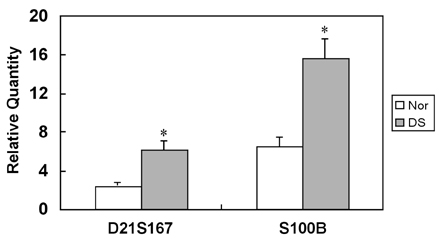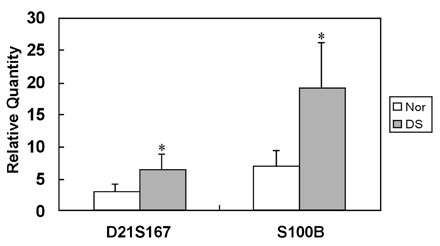Yonsei Med J.
2005 Apr;46(2):193-197. 10.3349/ymj.2005.46.2.193.
Rapid Prenatal Diagnosis of Trisomy 21 by Real-time Quantitative Polymerase Chain Reaction with Amplification of Small Tandem Repeats and S100B in Chromosome 21
- Affiliations
-
- 1Department of Obstetrics and Gynecology, Yonsei University College of Medicine, Seoul, Korea. ob@yumc.yonsei. ac.kr
- 2Division of Prenatal Genetics Clinic, Yonsei University College of Medicine, Seoul, Korea.
- 3The Genetic Laboratory of the Medical Research Center, Yonsei University College of Medicine, Seoul, Korea.
- KMID: 1734043
- DOI: http://doi.org/10.3349/ymj.2005.46.2.193
Abstract
- Trisomy 21 (Down syndrome) is the most common congenital anomaly, and it occurs in one out of 700-1000 births. Current techniques such as amniocentesis and chorionic villi sampling (CVS) require lengthy laboratory culture procedures and high costs. This study was undertaken to establish a rapid prenatal diagnosis of trisomy 21 using real-time quantitative polymerase chain reaction (PCR) of fetal DNA from amniotic fluid. Real-time quantitative PCR was performed with DNA templates obtained from 14 normal blood samples, 10 normal amniotic fluid samples, 14 Down syndrome blood samples, and 7 Down syndrome amniotic fluid samples. Primers for D21S167 and S100B of chromosome 21 were used. Primers that direct the amplification of the 165-bp fragment of the insulin-like growth factor (IGF) -1 gene on chromosome 12 using a PCR primer were included to generate an internal standard for quantitation. The relative levels of D21S167 and S100B were 2.6 and 2.4 times higher in the blood of Down syndrome patients than those in the control group. The differences between these two groups were statistically significant (p-values were 0.0012 and 0.0016, respectively). The relative levels of D21S167 and S100B were 2.1 and 2.7 times higher in the amniotic fluid of Down syndrome fetuses than those in the control group. The difference between these two groups was statistically significant (p-values were 0.0379 and 0.0379, respectively). Prenatal diagnosis of trisomy 21 by real-time quantitative PCR using STR (small tandem repeats) amplification of D21S167 and S100B is a useful, accurate and rapid diagnostic method. Furthermore, it may also be useful for prenatal diagnosis with fetal DNA from maternal blood, and for preimplantation genetic diagnosis and prenatal counseling.
MeSH Terms
Figure
Reference
-
1. Hook EB. Rates of chromosome abnormalities at different maternal ages. Obstet Gynecol. 1981. 58:282–285.2. Globus MS, Loughman WD, Epstein CJ, Halbasch G, Stephen JD, Hall BD. Prenatal genetic diagnosis in 3000 amniocentesis. N Engl J Med. 1979. 300:157–163.3. Yang YH, Kim MS, Park YW, Kim SK, Cho JS, Jeong HJ. Chorionic villus sampling: Experience of first 510 cases in Korean. Korean J Obstet Gynecol. 1993. 36:906–915.4. Yang YH, Park YW, Kim SK, Cho JS, Jeong MJ, Kim HS, et al. Chorionic villus sampling: clinical experience of the initial 750 cases. J Obstet Gynecol Res. 1996. 22:143–149.5. Yang YH, Kang JY, Yang ES, Jang SY, Cho JS, Park YW, et al. Clinical usefulness of fluorescence in situ hybridization in the diagnosis of genetic disease. Korean J Obstet Gynecol. 2002. 45:1016–1025.6. Beggs AH, Kunkel LM. Improved diagnosis of Duchenne/Becker muscular dystrophy. J Clin Invest. 1990. 85:613–619.7. Mansfield ES. Diagnosis of down syndrome and other aneuploidies using quantitative polymerase chain reaction and small tandem repeat polymorphisms. Hum Mol Genet. 1993. 2:43–50.8. Yang YH, Kim IK, Oh SH, Kim CK, Kim JY. Rapid prenatal diagnosis of trisomy 21 by polymerase chain reaction associated analysis of small tandem repeats and S100B in chromosome 21. Fetal Diagn Ther. 1998. 13:361–366.9. von Eggeling F, Freytag M, Fahsold R, Horsthemke B, Claussen U. Rapid detection of trisomy 21 by quantitative PCR. Hum Genet. 1993. 91:567–570.10. Findlay I, Toth T, Matthews P, Marton T, Quirke P, Papp Z. Rapid trisomy diagnosis (21, 18 and 13) using fluorescent PCR and short tandem repeats: applications for prenatal diagnosis and preimplantation genetic diagnosis. J Assist Reprod Genet. 1998. 15:266–275.11. Findlay I, Matthews P, Toth T, Quirke P, Papp Z. Same day diagnosis of Down's syndrome and sex in single cells using multiplex fluorescent PCR. Mol Pathol. 1998. 51:164–167.12. Lee HH, Chang JG, Lin SP, Chao HT, Yang ML, Ng HT. Rapid detection of trisomy 21 by homologous gene quantitative PCR (HGQ-PCR). Hum Genet. 1997. 99:364–367.13. Grove DS. Quantitative real-time polymerase chain reaction for the core facility using TaqMan and the Perkin-Elmer/Applied Biosystems Division 7700 sequence detector. J Biomol Tech. 1999. 10:11–16.14. Guo Z, Sharma V, Patterson D, Litt M. TG repeat polymorphism at the D21S167 locus. Am J Hum Genet. 1990. 46:776–783.15. Keuren M, Drabkin H, Hart I, Harker D, Patterson D, Vora S. Regional assignment of human liver-type 6-phosphofructokinase to chromosome 21q22.3 by using somatic cell hybrids and a monoclonal anti-L antibody. Hum Genet. 1986. 74:34–40.16. Lo YMD, Tein MSC, Lau TK, Haines CJ, Leung TN, Poon PMK, et al. Quantitative analysis of fetal DNA in maternal plasma and serum: implications for noninvasive prenatal diagnosis. Am J Hum Genet. 1998. 62:768–775.17. Zhong XY, Holzgreve W, Hahn S. Detection of fetal Rhesus D and sex using fetal DNA from maternal plasma by multiplex polymerase chain reaction. BJOG. 2000. 107:766–769.18. Zhong XY, Hahn S, Holzgreve W. Prenatal identification of fetal genetics traits. Lancet. 2001. 357:310–311.19. Houfflin-Debarge V, O'Donnell H, Overton T, Benntee PR, Fisk NM. High sensitivity of fetal DNA in plasma compared to serum and nucleated cells using unnested PCR in maternal blood. Fetal Diagn Ther. 2000. 15:102–107.20. Honda H, Miharu N, Ohashi Y, Ohama K. Successful diagnosis of fetal gender using conventional PCR analysis of maternal serum. Clin Chem. 2001. 47:41–46.21. Honda H, Miharu N, Ohashi Y, Samura O, Kinutani M, Hara T, et al. Fetal gender determination in early pregnancy through qualitative and quantitative analysis of fetal DNA in maternal serum. Hum Genet. 2002. 110:75–79.22. Bianchi DW, Leshane ES, Cowan JM. Large amounts of cell-free fetal DNA are present in amniotic fluid. Clin Chem. 2001. 47:1867–1869.23. Lo YMD, Corbetta N, Chamberlain PF, Rai V, Sargent IL, Redman CW, et al. Presence of fetal DNA in maternal plasma and serum. Lancet. 1997. 350:485–487.
- Full Text Links
- Actions
-
Cited
- CITED
-
- Close
- Share
- Similar articles
-
- Rapid Prenatal Diagnosis of Trisomy 21 by Real-Time Quantitative Polymerase Chain Reaction
- Rapid Prenatal Detection of Down and Edwards Syndromes by Fluorescent Polymerase Chain Reaction with Short Tandem Repeat Markers
- Rapid Prenatal Diagnosis of Down Syndrome Using Quantitative Fluorescent PCR in Uncultured Amniocytes
- Validation of QF-PCR for Rapid Prenatal Diagnosis of Common Chromosomal Aneuploidies in Korea
- Application of digital polymerase chain reaction technology for noninvasive prenatal test



